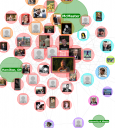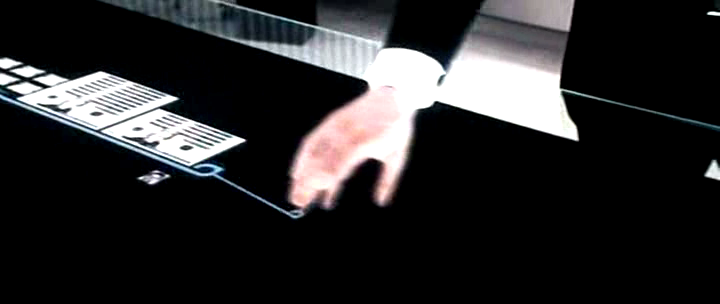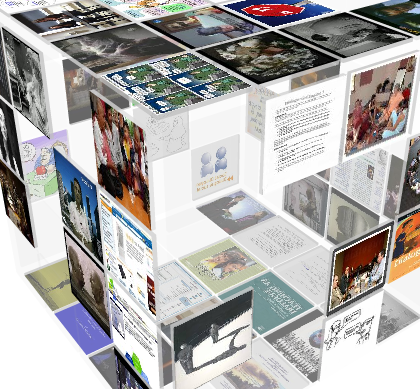I just blogged about the interface ideas in Stranger than Fiction from MK12. Turns out they were behind the interface for MI5 in the latest James Bond – see UI’s from Movies – Quantum of Solace and see the response from MK12. For images from the movie see NUI Group: Quantom of Solace images.
Category: Interface Design and Usability
search-cube – the Visual Search Engine
Stan pointed me to search-cube – the Visual Search Engine which generates a 3D cube of images from your search results. It’s a mashup of Google image search. I’m not sure if it is more effective than just looking at the results from a Google Image search, but I like the way panels are missing so you can see through the cube to stuff on the other side.
If life had an interface: Stranger than Fiction
 I just found that someone has posted on YouTube the introduction to the movie Stranger than Fiction where, with Emma Thomson’s voice narrating, we see Will Farrell’s accountant character’s life surveyed with an overlay of explanatory graphics. I’m not sure what to call the graphics – they sometimes look like a visualization of what Crick (the character) thinks about as he walks and counts. They sometimes seem to document aspects of Crick’s life, like how many items he puts in the dishwasher each night or how he ties his tie. They behave like augmented reality information graphics meant to add information for the viewer, but information that has the character of the character.
I just found that someone has posted on YouTube the introduction to the movie Stranger than Fiction where, with Emma Thomson’s voice narrating, we see Will Farrell’s accountant character’s life surveyed with an overlay of explanatory graphics. I’m not sure what to call the graphics – they sometimes look like a visualization of what Crick (the character) thinks about as he walks and counts. They sometimes seem to document aspects of Crick’s life, like how many items he puts in the dishwasher each night or how he ties his tie. They behave like augmented reality information graphics meant to add information for the viewer, but information that has the character of the character.
According to information aesthetics the infographics were developed by the MK12 Tactical Design and Research Bureau. Now if life had an interface, I’d like it to be stranger than fiction.
NY Times: Is This the Future of the Digital Book?
Christian V. pointed me to a New York Times story on Is This the Future of the Digital Book? (Brad Stone, April 4, 2009).
Wattpad, based in Toronto, is among several start-ups soliciting the work of unpublished authors, giving them a route around the big book companies and then distributing their writing on the Web and on mobile phones. Wattpad draws its revenue from advertising and, for now at least, does not pay the authors.
Smart phones now have larger and brighter screens so it is possible people will use them to read, but I’m not yet convinced. Will weaving multimedia into the book save it?
April Interface: Opera Face Gestures
Calen H. sent me a link to a very funny YouTube video on Opera Face Gestures. The idea is to control the Opera browser by making faces. Almost good enough to be implemented.
INKE: Implementing New Knowledge Environments
Congratulations to Ray Siemens and company for INKE: Implementing New Knowledge Environments which got funding as a Major Collaborative Research Initiative from SSHRC. I’m part of the Interface Design group led by Stan Ruecker.
Taco Lab Blog: Siftables and American Shanzhai?
The Taco Lab who are probably best known for the Siftables (small cookie-sized tile computes that sense each other) shown at TED have a blog with some interesting posts like this one on American Shanzhai?. Shanzai literally means “mountain fortress” or the hideout of bandits and it refers to pirate activities like hacking cheap copies of consumer goods (that are heavily marked up.) It is now beginning to refer to a creative subculture of improving or altering electronics outside state (and IP) control. Thus the image above is from the Taco Lab blog and is a example of this creative shanzai – in this case a cell-phone/cigarette pack whose value is in its uniqueness. This got me thinking of all the open projects out there that make it easier to hack things like:
- TuxPhone – a project to develop open hardware and software for a cell phone.
- Arduino – an open electronics prototyping platform that’s great for interactive art projects
- LilyPad Arduino – an open device that is light enough for wearables and e-textile projects
- William Turkel’s Fabrication Lab – a unique (to my knowledge) humanities lab
Webilus.com: the best of the images of the web
Webilus.com :: le meilleur des images du web is a French web site that gathers images and visualizations of the web and computing culture. The image above, for example, compares e-mail collaboration to wiki collaboration showing how much more work it is to use e-mail.
The site is a blog curated by Frédéric COZIC and it has a widget you can install to see the most recent images on your blog.
The Pool
 The Pool is a project from the University of Maine new media group, Still Water who also developed ThoughtMesh. It is a collaboration between faculty and students that provides a visual space where ideas can be described (intent), approached and released. (The metaphor is fishing and releasing.) It encourages sharing, rating, and redevelopment of ideas. The have pools for code and art.
The Pool is a project from the University of Maine new media group, Still Water who also developed ThoughtMesh. It is a collaboration between faculty and students that provides a visual space where ideas can be described (intent), approached and released. (The metaphor is fishing and releasing.) It encourages sharing, rating, and redevelopment of ideas. The have pools for code and art.
The Pool offers a very different message. This online environment is an experiment in sharing art, text, and code–not just sharing digital files themselves, but sharing the process of making them. In place of the single-artist, single-artwork paradigm favored by the overwhelming majority of studio art programs and collection management systems, The Pool stimulates and documents collaboration in a variety of forms, including multi-author, asynchronous, and cross-medium projects. (learn more -> purpose)
The Chronicle of Higher Education in New-Media Scholars’ Place in ‘the Pool’ Could Lead to Tenure (Andrea L. Foster, May 30, 2008, Volume 54, Issue 38, Page A10) discusses The Pool as an alternative form of peer review for getting tenure, which rather misses the point for me. What impresses me about this is the collaboration between students and faculty in experimentation around structured collaboration. The Pool could dry up, and some of the code pools seem rather poorly stocked, but that wouldn’t detract from what seems like thoughtful and sustained experimentation with social collaboration. The wiki, Flickr, Facebook and blog models of Web 2.0 social knowledge dominate our thinking about what is possible. The Pool reminds me that we don’t have to adapt successful models, there is room for new ideas. Catch this and release it.
TouchGraph Navigator for Facebook
 TouchGraph now has a Facebook Plugin that lets you visualize your friends and their location. Its an interesting example of what can be done with visualization of people and relationships.
TouchGraph now has a Facebook Plugin that lets you visualize your friends and their location. Its an interesting example of what can be done with visualization of people and relationships.




